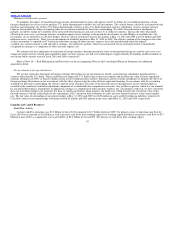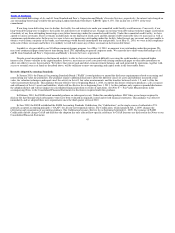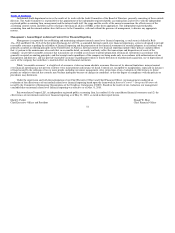Nike 2010 Annual Report Download - page 54
Download and view the complete annual report
Please find page 54 of the 2010 Nike annual report below. You can navigate through the pages in the report by either clicking on the pages listed below, or by using the keyword search tool below to find specific information within the annual report.
Table of Contents
We carefully review all factors that drive the ultimate disposition of foreign earnings determined to be reinvested offshore, and apply stringent
standards to overcoming the presumption of repatriation. Despite this approach, because the determination involves our future plans and expectations of
future events, the possibility exists that amounts declared as indefinitely reinvested offshore may ultimately be repatriated. For instance, the actual cash
needs of our U.S. entities may exceed our current expectations, or the actual cash needs of our foreign entities may be less than our current expectations.
This would result in additional income tax expense in the year we determined that amounts were no longer indefinitely reinvested offshore. Conversely, our
approach may also result in a determination that accumulated foreign earnings (for which U.S. income taxes have been provided) will be indefinitely
reinvested offshore. In this case, our income tax expense would be reduced in the year of such determination.
On an interim basis, we estimate what our effective tax rate will be for the full fiscal year. The estimated annual effective tax rate is then applied to
the year−to−date pre−tax income excluding infrequently occurring or unusual items, to determine the year−to−date tax expense. The income tax effects of
infrequent or unusual items are recognized in the interim period in which they occur. As the fiscal year progresses, we continually refine our estimate based
upon actual events and earnings by jurisdiction during the year. This continual estimation process periodically results in a change to our expected effective
tax rate for the fiscal year. When this occurs, we adjust the income tax provision during the quarter in which the change in estimate occurs so that the
year−to−date provision equals the expected annual rate.
On a quarterly basis, we reevaluate the probability that a tax position will be effectively sustained and the appropriateness of the amount recognized
for uncertain tax positions based on factors including changes in facts or circumstances, changes in tax law, settled audit issues and new audit activity.
Changes in our assessment may result in the recognition of a tax benefit or an additional charge to the tax provision in the period our assessment changes.
We recognize interest and penalties related to income tax matters in income tax expense.
Other Contingencies
In the ordinary course of business, we are involved in legal proceedings regarding contractual and employment relationships, product liability claims,
trademark rights, and a variety of other matters. We record contingent liabilities resulting from claims against us, including related legal costs, when a loss
is assessed to be probable and the amount of the loss is reasonably estimable. Assessing probability of loss and estimating probable losses requires analysis
of multiple factors, including in some cases judgments about the potential actions of third party claimants and courts. Recorded contingent liabilities are
based on the best information available and actual losses in any future period are inherently uncertain. If future adjustments to estimated probable future
losses or actual losses exceed our recorded liability for such claims, we would record additional charges as other (income) expense, net during the period in
which the actual loss or change in estimate occurred. In addition to contingent liabilities recorded for probable losses, we disclose contingent liabilities
when there is a reasonable possibility that the ultimate loss will materially exceed the recorded liability. Currently, we do not believe that any of our pending
legal proceedings or claims will have a material impact on our financial position or results of operations.
Item 7A. Quantitative and Qualitative Disclosures about Market Risk
In the normal course of business and consistent with established policies and procedures, we employ a variety of financial instruments to manage
exposure to fluctuations in the value of foreign currencies and interest rates. It is our policy to utilize these financial instruments only where necessary to
finance our business and manage such exposures; we do not enter into these transactions for speculative purposes.
We are exposed to foreign currency fluctuation as a result of our international sales, product sourcing and funding activities. Our foreign exchange
risk management program is intended to minimize both the positive or negative effects of currency fluctuations on our consolidated results of operations,
financial position and cash
51
























